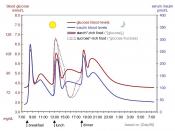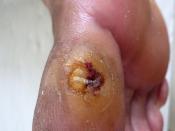Patient: D.M. Age: 76
Location: Meadowview 1st Floor Student: Emily Soto
Date of care: 10/24/07
Medical Diagnosis: Diabetes Mellitus
Diabetes is a disease in which the body doesn't produce or properly use insulin. Insulin is a hormone that is produced by specialized cells (beta cells) of the pancreas. (The pancreas is a deep-seated organ in the abdomen located behind the stomach.) Insulin is needed to turn sugar and other food into energy. In addition to helping glucose (which is the simple sugar that serves as the chief source of energy in the body) enter the cells; insulin is also important in tightly regulating the level of glucose in the blood. After a meal, the blood glucose level rises. In response to the increased glucose level, the pancreas normally releases more insulin into the bloodstream to help glucose enter the cells and lower blood glucose levels after a meal. When the blood glucose levels are lowered, the insulin release from the pancreas is turned down.
(Guthrie, 2004)
There are three types of diabetes Type (2) two, Type (1) one, and Gestational Diabetes. First, diabetes mellitus type (2) two is a metabolic disorder that is primarily described by insulin resistance, which is a condition in which normal amounts of insulin are insufficient to produce a normal insulin response from fat, muscle and liver cells. It is often managed by engaging in exercise and adjusting one's diet. Type (2) two may go disregarded for years in a patient before diagnosis, since the symptoms are typically milder and can be irregular. Nevertheless, severe difficulties can result from unnoticed type (2) two diabetes, including renal failure (which is a condition in which the kidneys fail to function adequately), blindness, wounds that fail to heal, and coronary artery disease (is a disease characterized by reduced...


